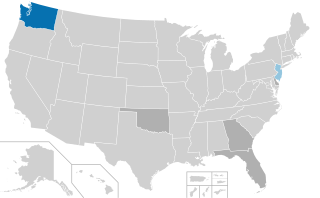
The 2002 United States elections were held on November 5, in the middle of Republican President George W. Bush's first term. Republicans won unified control of Congress, picking up seats in both chambers of Congress, making Bush the first President since Franklin D. Roosevelt in 1934 to gain seats in both houses of Congress. In the gubernatorial elections, Democrats won a net gain of one seat. The elections were held just a little under fourteen months after the September 11 attacks. Thus, the elections were heavily overshadowed by the War on Terror, the impending Iraq War, the early 2000s recession, and the sudden death of Democratic Senator Paul Wellstone of Minnesota about one week before the election.
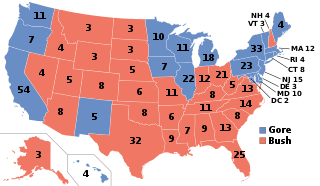
The 2000 United States elections were held on November 7, 2000. Republican Governor George W. Bush of Texas defeated Democratic Vice President Al Gore of Tennessee in the presidential election. Republicans retained control of both houses of Congress, giving the party unified control of Congress and the presidency for the first time since the 1954 elections.

The 2012 United States elections took place on November 6, 2012. Democratic President Barack Obama won reelection to a second term and the Democrats gained seats in both chambers of Congress, retaining control of the Senate even though the Republican Party retained control of the House of Representatives. As of 2022, this is the most recent election cycle in which neither the presidency nor a chamber of Congress changed partisan control, and the last time that the winner of the presidential race provided coattails for their party in both the House of Representatives and the Senate.
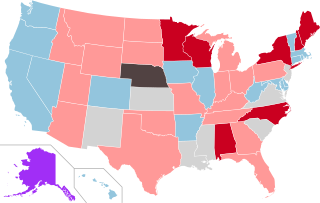
The 2010 United States state legislative elections were held on November 2, 2010, halfway through President Barack Obama's first term in office. Elections were held for 88 legislative chambers, with all states but Louisiana, Mississippi, New Jersey, and Virginia holding elections in at least one house. Kansas and New Mexico held elections for their lower, but not upper houses. Four territorial chambers in three territories and the District of Columbia were up as well.
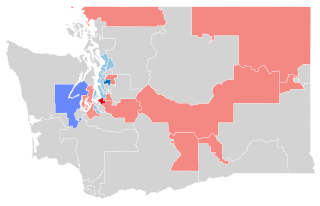
The 2014 Washington State Senate elections is one of the biennial legislative elections in Washington took place on November 4, 2014. In this election, about half of the 49 legislative districts in Washington chose a state senator for a four-year term to the Washington State Senate. The other half of state senators were chosen in the next biennial election, so that about half of the senators are elected at a time: one group in presidential election years and the other in other even-numbered election years. All the members of the Washington State House of Representatives are elected concurrently with half of the senators every two years.

The 2016 United States elections were held on Tuesday, November 8, 2016. Republican nominee Donald Trump defeated Democratic former Secretary of State Hillary Clinton in the presidential election, while Republicans retained control of Congress. This marked the first and most recent time Republicans won or held unified control of the presidency and Congress since 2004.

The 2018 United States elections were held on Tuesday, November 6, 2018. These midterm elections occurred during Incumbent Republican President Donald Trump's term. Although the Republican Party increased its majority in the Senate, unified Republican control of Congress and the White House was brought to an end when the Democratic Party won control of the House of Representatives in what was widely characterized as a "blue wave" election.
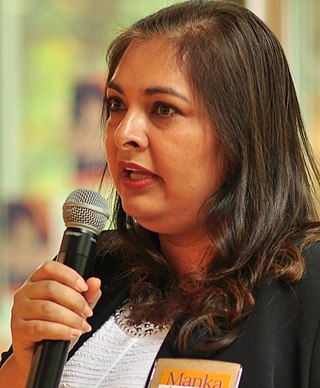
A special election was held on November 7, 2017, to fill the vacant seat in the Washington State Senate representing the 45th district. The seat was left vacant after the death of incumbent Andy Hill in October 2016. Dino Rossi, a former candidate for U.S. Senate in 2010 and for governor in 2004 and 2008, was appointed to fill the seat until the election. He announced that he would not run for the seat. The election was then contested between Manka Dhingra of the Democratic Party and Jinyoung Lee Englund of the Republican Party, who advanced as the top two finishers in the August primary. Dhingra won the election by more than ten percent, giving the Democratic caucus a 25–24 majority for the 2018 session.

Manka Dhingra is an Indian-American attorney and politician who is a Washington State senator. A member of the Democratic Party, she was elected to represent the 45th legislative district, on Seattle's Eastside in King County, during a 2017 special election. Dhingra is the first Sikh elected to any state legislature in the United States.

The 2020 United States state legislative elections were held on November 3, 2020, for 86 state legislative chambers in 44 states. Across the fifty states, approximately 65 percent of all upper house seats and 85 percent of all lower house seats were up for election. Nine legislative chambers in the five permanently-inhabited U.S. territories and the federal district of Washington, D.C. also held elections. The elections took place concurrently with several other federal, state, and local elections, including the presidential election, U.S. Senate elections, U.S. House elections, and gubernatorial elections.

The 2018 United States state legislative elections were held on November 6, 2018, for 87 state legislative chambers in 46 states. Across the fifty states, approximately 56 percent of all upper house seats and 92 percent of all lower house seats were up for election. Additionally, six territorial chambers in four territories and the District of Columbia were up as well.

The 2022 United States state legislative elections were held on November 8, 2022, for 88 state legislative chambers in 46 states. Across the fifty states, approximately 56 percent of all upper house seats and 92 percent of all lower house seats were up for election. Additionally, six territorial chambers were up in four territories and the District of Columbia. These midterm elections coincided with other state and local elections, including gubernatorial elections in multiple states.
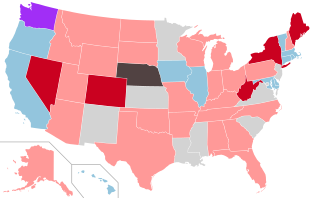
Elections to state legislatures were held in 46 U.S. states in 2014 with a total of 6,049 seats up for election. Six territorial chambers were up in four territories and the District of Columbia.

The 2015 United States state legislative elections were held on November 3, 2015. Seven legislative chambers in four states held regularly scheduled elections. These off-year elections coincided with other state and local elections, including gubernatorial elections in three states.

The 2013 United States state legislative elections were held on November 5, 2013. Three legislative chambers in two states held regularly-scheduled elections. These off-year elections coincided with other state and local elections, including gubernatorial elections in two states.

The 2011 United States state legislative elections were held on November 8, 2011. Eight legislative chambers in four states held regularly scheduled elections. These off-year elections coincided with other state and local elections, including gubernatorial elections in four states.

The 2016 United States state legislative elections were held on November 8, 2016, for 86 state legislative chambers in 44 states. Across the fifty states, approximately 65 percent of all upper house seats and 85 percent of all lower house seats were up for election. Nine legislative chambers in the five permanently-inhabited U.S. territories and the federal district of Washington, D.C. also held elections. The elections took place concurrently with several other federal, state, and local elections, including the presidential election, U.S. Senate elections, U.S. House elections, and gubernatorial elections.
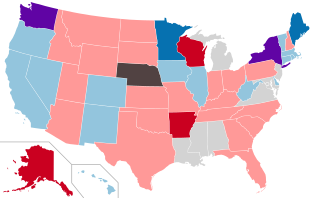
The 2012 United States state legislative elections were held on November 6, 2012, for 86 state legislative chambers in 44 states. Across the fifty states, approximately 65 percent of all upper house seats and 85 percent of all lower house seats were up for election. Nine legislative chambers in the five permanently-inhabited U.S. territories and the federal district of Washington, D.C. also held elections. The elections took place concurrently with several other federal, state, and local elections, including the presidential election, U.S. Senate elections, U.S. House elections, and gubernatorial elections.
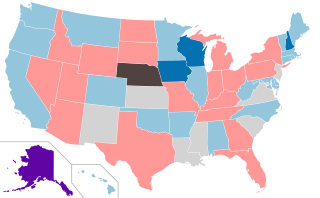
The 2006 United States state legislative elections were held on November 7, 2006, halfway through President George W. Bush's second term in office. This election was a wave elections in the United States election, and saw Democrats simultaneously reclaim both houses of Congress and pick up six governorships. Elections were held for 90 legislative chambers, with all states but Louisiana, Mississippi, New Jersey, and Virginia holding elections in at least one house. Kansas, New Mexico, and South Carolina held elections for their lower, but not upper house. Four territorial chambers in three territories and the District of Columbia were up, including the newly created territorial legislature in the U.S. Virgin Islands.

The 2002 United States state legislative elections were held on November 5, 2002, halfway through President George W. Bush's first term in office. This was a unique election in which the incumbent Republican party performed surprisingly well for a midterm election. Elections were held for 91 legislative chambers, with all states but Louisiana, Mississippi, New Jersey, and Virginia holding elections in at least one house. Three territorial chambers in two territories and the District of Columbia were up as well.
